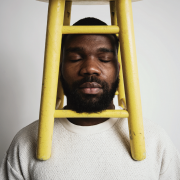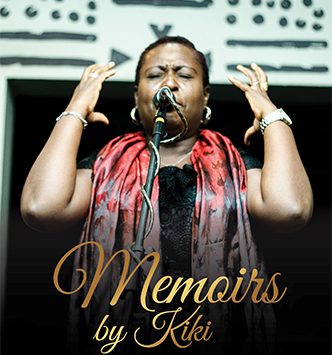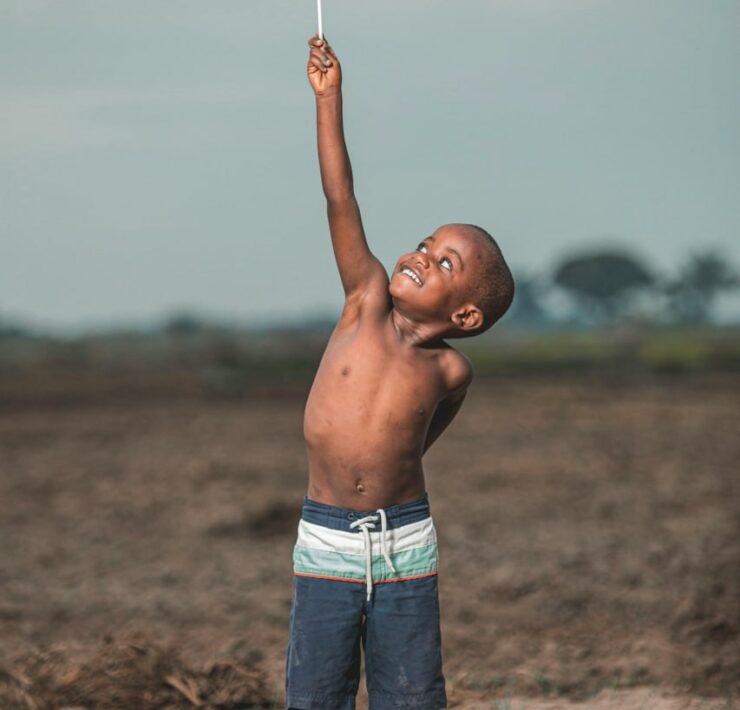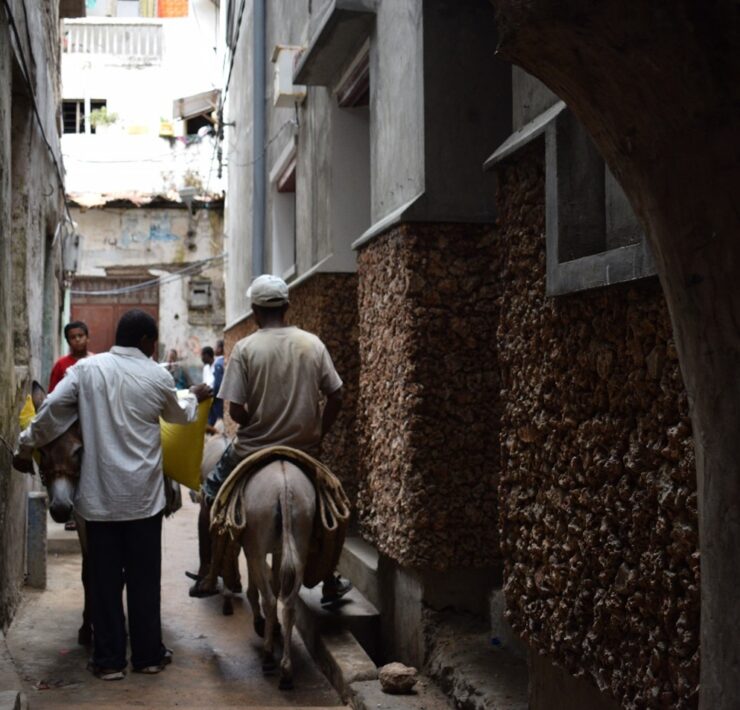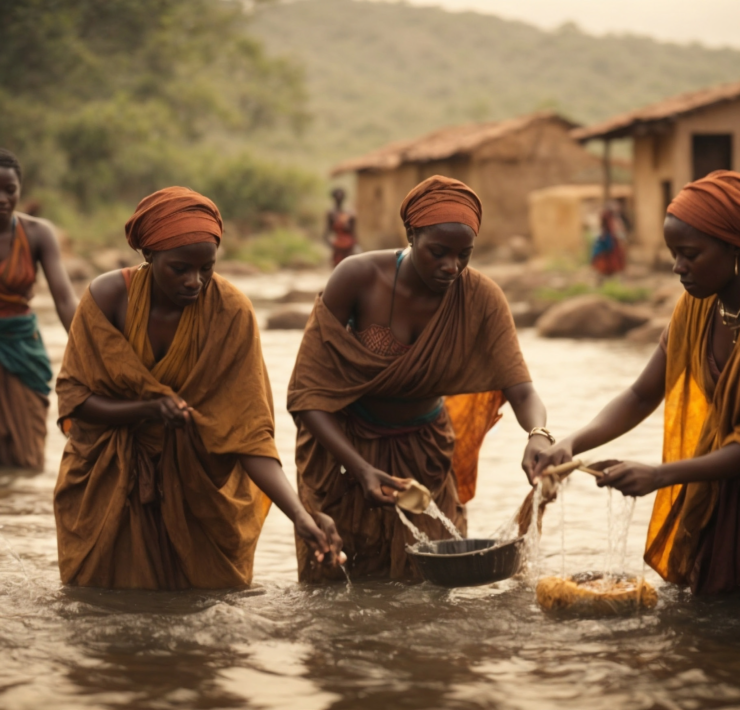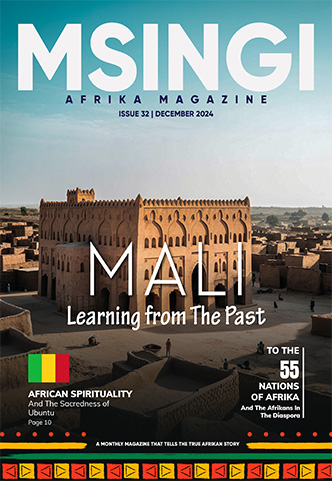Coffee: The Ethiopian Golden Beverage
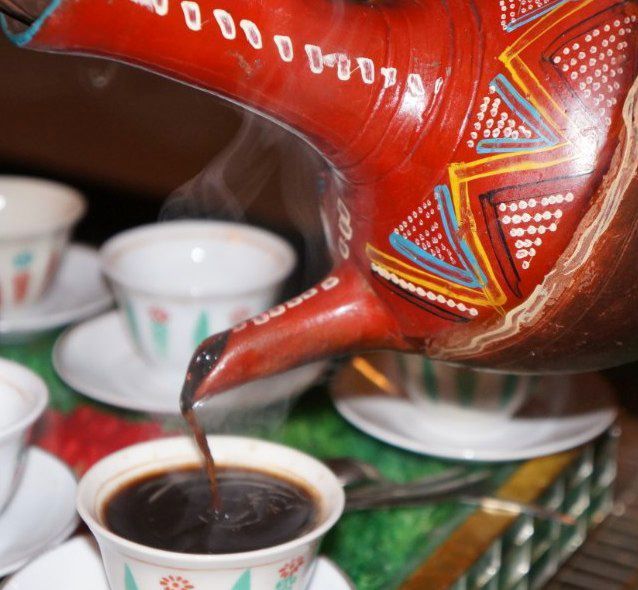
Samuel Phillips is a writer, graphic designer, photographer, songwriter, singer…
I can’t tell you really that coffee is my go-to beverage among the multitudes of beverages available in the market. Somehow coffee stands out in the world of beverages and mood-enhancing drinks. Personally, I think I love coffee for its fine aroma more than I love it for its taste. The aroma always hit the right spot in my brain. And oh before I forget, coffee is my go-to beverage when mixed with milk. I love the mix and it’s perfect. But I am a sincere hater of black coffee, apologies to those diehard fans of black coffee.
Like everything we have in our world today, there is one origin story or another about their source. Coffee is one of those heart-blessing beverages with a rich history which emanated from Ethiopia in East Afrika. I hope that’s not just the reason I am writing about coffee in this issue. I didn’t tell you, I love Ethiopia to bits, and everything coming out of Afrika has now become a thing passion for me. Well, now you know.
History of coffee
No one knows exactly how or when coffee was discovered, though there are many legends about its origin. Coffee grown worldwide can trace its heritage back centuries to the ancient coffee forests on the Ethiopian plateau. There, legend says the goat herder Kaldi first discovered the potential of these beloved beans. The story goes that that Kaldi discovered coffee after he noticed that after eating the berries from a certain tree, his goats became so energetic that they did not want to sleep at night. Kaldi reported his findings to the abbot of the local monastery, who made a drink with the berries and found that it kept him alert through the long hours of evening prayer. The abbot shared his discovery with the other monks at the monastery, and knowledge of the energizing berries began to spread. As word moved east and coffee reached the Arabian Peninsula, it began a journey which would cause these beans to traverse the globe.
Ethiopia first started exporting coffee in the 15th century. Coffee was brought by Somali merchants to Yemen where Sufi mystics drank it so that they could better concentrate on their chanting. A couple of centuries later, the Ethiopian Orthodox Church banned coffee altogether. Ethiopians only went back to consuming coffee in the late 19th century thanks to Emperor Menelik II who himself was fond of the beverage. After that, Ethiopia’s coffee production and exportation soared. Today, coffee accounts for about 70% of all export earnings and is essential to the country’s economy. An estimated 15 million Ethiopians—a quarter of the country’s population—make their living from growing coffee.
With the exception of a few large government-run estates, nearly all of Ethiopia’s coffee is grown by small-scale farmers who continue to implement traditional methods. Coffee farmers grow the so-called “garden coffees” on smallholdings. These plots usually cover less than a hectare of land and yield on average around 300 kg of coffee per year.
Ethiopia
Somehow, Ethiopia has become one of my favorite Afrikan countries and this was not the case up until late 2018 when my wife and I visited that beautiful country. One of the many things that caught my attention on our first day, right at the airport, was the professional demeanor of the immigration officer who stamped my passport, after asking just a few questions unlike, what I have been asked in other airports. You know when your passport says “Nigerian”, some kind of unseen antennas are quickly raised, but he was more interested in whether I knew where I was going in the capital, Addis, and whether I had the phone number of my host. Of which I responded in the affirmative. He seemed more interested in my safety than the many other unnecessary issues one faces at airports, and with a big fine smile, as warm as a mug of milky coffee, he said “welcome to Ethiopia.”
I remember a few days after our arrival in Addis, my wife and I took a little tour of Addis. We went to Entoto Mountain situated nine kilometers north of the city center, Addis Ababa with the altitudinal location ranging from 2,600 to 3,200 meters above sea level. Entoto Mountain houses one Ethiopia’s heritage monasteries, Entoto St. Mary church. It is a beautiful sight to behold from the exterior from where we stood to view the edifice. From the way the locals in that mountain responded to our presence, you could tell this was home for anyone looking for a gentle and peaceful place to visit.
The story has it that the establishment of Entoto St. Mary church came through prophecy. The prophecy was about a king who would build a church in honor of the Virgin Mary on Entoto Mountain. In 1882 the then king of Shewa Menelik waged a war against Tekle Haymanot of Gojjam at Embabo (Amare and Fasil, 1987; Hailegebreil, 1987).
At this battle, King Tekle Haymanaot went to the battle with a number of Tabots and Menelik won easily and took away many treasures. Among the most valuable objects captured with Tekle Haymanaot was a tabot of St. Mary (Zemedkun, 1992).
Hence, the origin of the tabot of Entoto St. Mary is largely associated with a fascinating story. It is believed that the age of the tabot goes back to the time of Atse Dawit (1380-1430). According to Haile siilsase Atse Dawit brought the tabot of St. Mary from Bulga and placed it at Entoto. Even though much later in the 16th century, Entoto St. Mary church, like other churches of the time, was a victim of Ahimed Giragn’s war, the community and the clergy of Entoto managed to rescue the Tabot to Gondar.
We couldn’t stay or do much on Entoto Mountain on the day we visited, because it happened to be a special annual service day, so photography was basically not allowed and also we had issues with our travel card and couldn’t access much spending money. So we cut down our expenses so as not to get stranded on that trip. But it was fun all the same walking on that land filled with such rich ancient heritage.
Around Addis
A walk around Addis is quite magical for me, for when you see faithful who practice the religion of orthodoxy bowing down on the streets facing their temples in prayers, then you will instantly know how religious Ethiopians are and how devoted they are to what they believe. I found it strange though, for even in the public bus, you would see faithful praying toward the temples as the bus passes by these sites. But it’s worth the sight and the magic that comes with it.

I remember how we were hailed and called “Afrikans” as we passed a group of men drinking coffee. We were even asked to join them in their coffee drinking, but I was focused on getting photos for my collection and my wife was trying to get a local scarf, so we passed on the opportunity to sit with them. I must say I regretted not having a seat with them, at least I would have learnt a new thing from them. And besides, of what use is a visit to such an ancient land without relating with the locals. I won’t make that mistake next time.
Jebena Buna
Another thing I must say I regretted not doing in Addis was not tasting the famous very strong Ethiopian home-brewed Jebena Buna coffee. My wife had told me about it even before we visited Addis and how very black and strong it is. I guess that’s one reason I didn’t agree to have a drink even when I had the opportunity to do so. That mistake too will be corrected whenever I visit Ethiopia again.
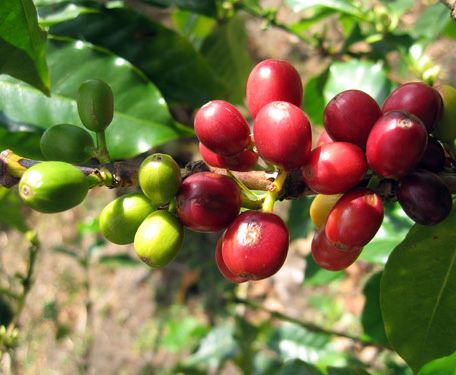
J__ebena buna, as it’s called in the local Amharic language, is an Ethiopian coffee ceremony and like it’s popularly said it is not designed for someone in a hurry. The preparation can be excruciatingly slow. But I think slow is good for a great Jebena Buna and for anything of worth. First, coffee cherries are picked, when red and ripe and peeled to expose the raw coffee bean.
The host — the youngest female in the family — then heats water in a long-necked black clay pot, over hot coals. The black clay pot is known as a jebena.
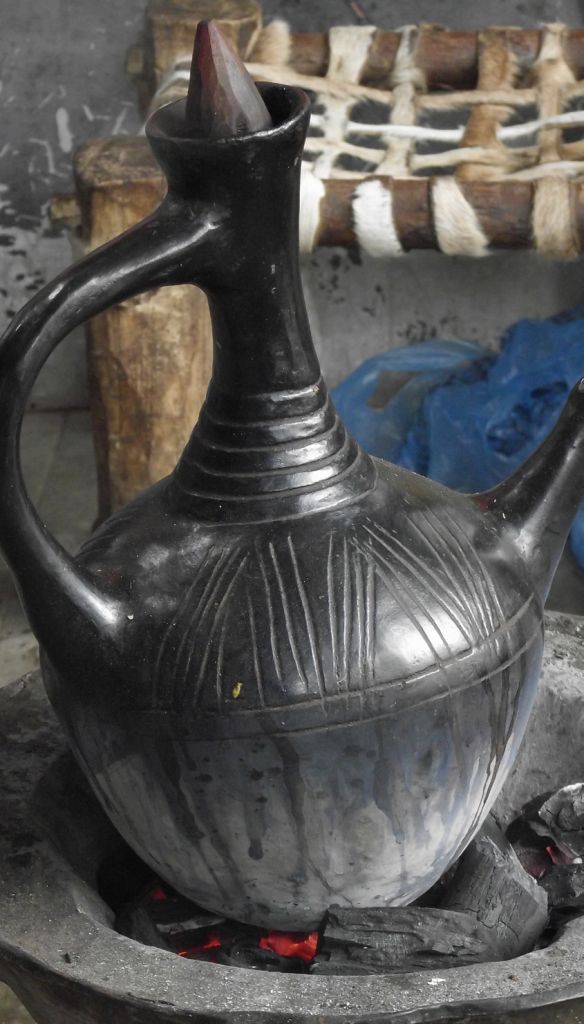
A traditional coffee ceremony is always conducted by the youngest female in the family. It is an honor to host the ceremony, and every step and guest is carefully attended to. With the water starting to simmer, she roasts the beans on a thin, open-faced pan. She keeps the roast as even as possible by stirring them constantly. It’s up to the host how long the beans are roasted. Depending on your host, she may stop the roasting once the beans are a light brown, or she may continue until they are slightly blackened and coated with essential oils.
The next moments are some of the most iconic to the ceremony. The host will come to each and every guest to soak them in the aromas the smoke carries, saturating them in it. At the same time, incense is also burned to compliment the coffee’s already rich fragrance. If the aroma is unwelcomed, the host will have to start the entire process again.
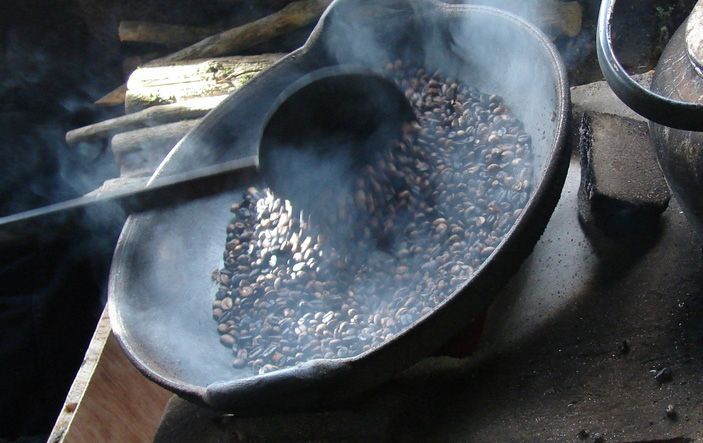
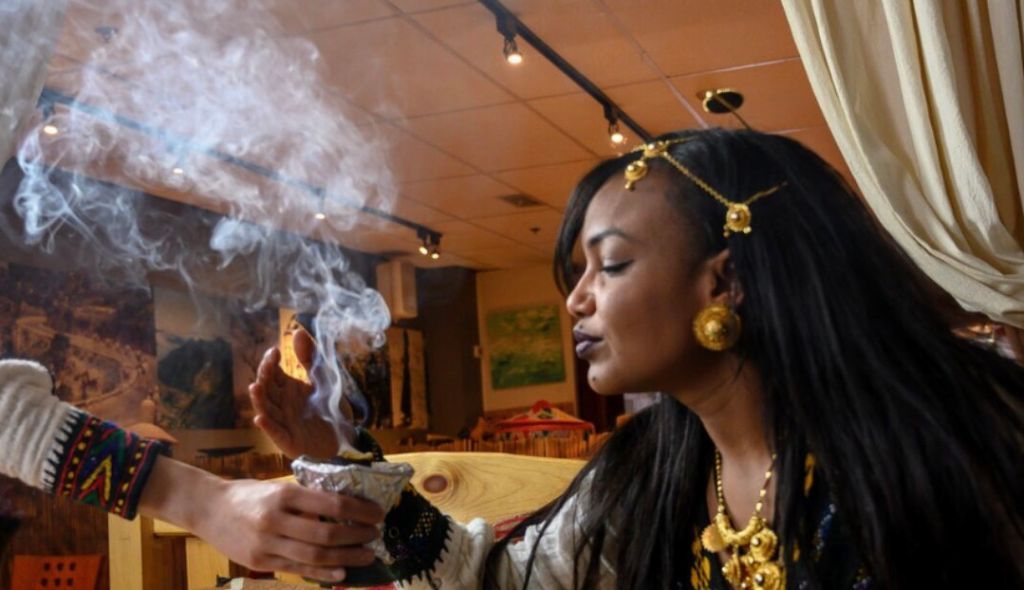
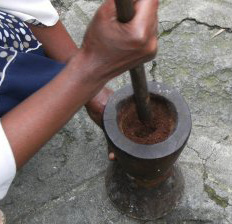
Next, the roasted beans are ground into a fine powder in a thick wooden bowl called a mukecha using a zenezena, which is a wooden or metallic cylinder with a blunt end. Once ground, the coffee is then poured into the boiling water in the jebena and allowed to boil. The host decides if the coffee should boil till it’s very black or just lightly dark. The longer it boils, the darker and stronger it gets.
Serving the coffee itself is an art that is mastered over time. It involves using a lot of sugar to sweeten the very black and bitter coffee. A typical Ethiopian Buna is served with a lot of sugar and is accompanied with the tenaAdam leaves. The host arranges a tray of very small, ceramic cups and artfully pours the coffee in a single stream from about a foot above the cups, which is far harder to do than it may sound. Obviously, a lot of time and art is expended in bringing out the flavor of one of the world’s most popular coffee drinks and thank God for Ethiopia’s mastery of such amazing art.

Afrika is a continent blessed with all manner of beautiful cultures, traditions, art and every form of heritage passed down for generations. I respect every unique culture outside of Afrika, but I will always give special thoughts to the cultures and arts of my home called Afrika. Forgive my bias.
So I have promised myself whenever I make a trip to any country in Afrika outside of my base, I will take time out to enjoy and appreciate the diverse cultures, foods, drinks and most especially the people.
You should do the same.
Welcome to Afrika, the vast land of multiple cultures.
What's Your Reaction?
Samuel Phillips is a writer, graphic designer, photographer, songwriter, singer and a lover of God. As an Afrikan content creator, he is passionate about creating a better image and positive narrative about Afrika and Afrikans. He is a true Afrikan who believes that the true potential of Afrika and Afrikans can manifest through God and accurate collaborations between Afrikans. Afrika is the land of kings, emperors, original wisdom, ancient civilizations, great men and women and not some road-side-aid-begging poor third world continent that the world finds joy in undermining.








